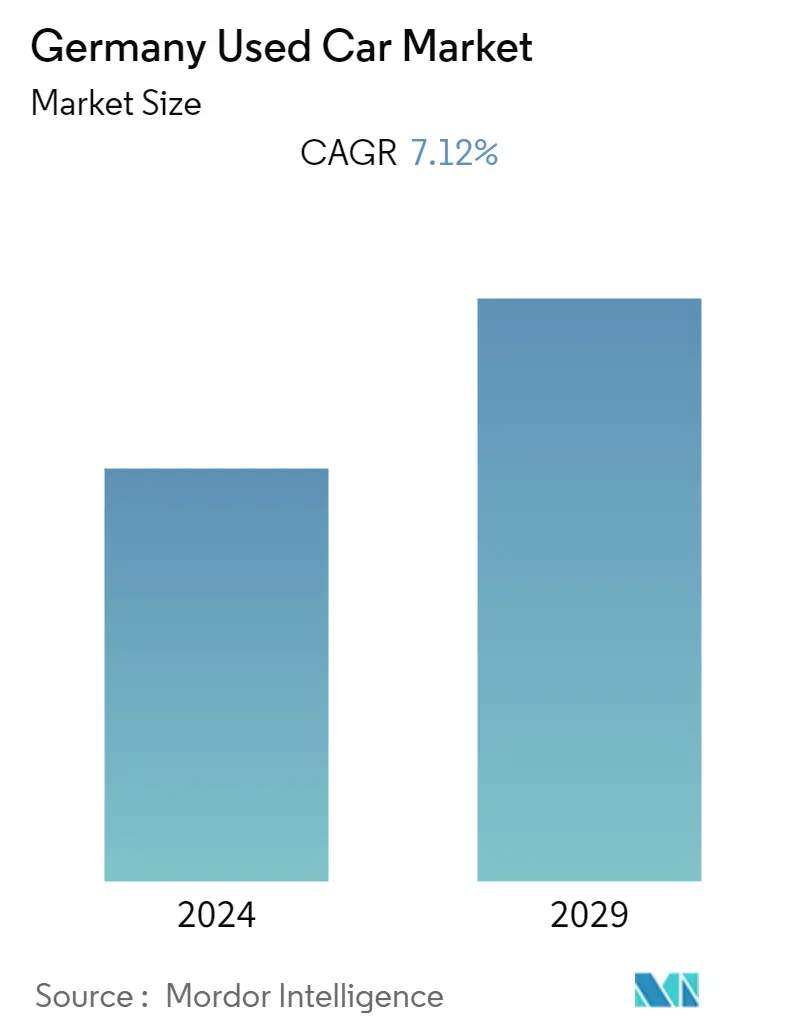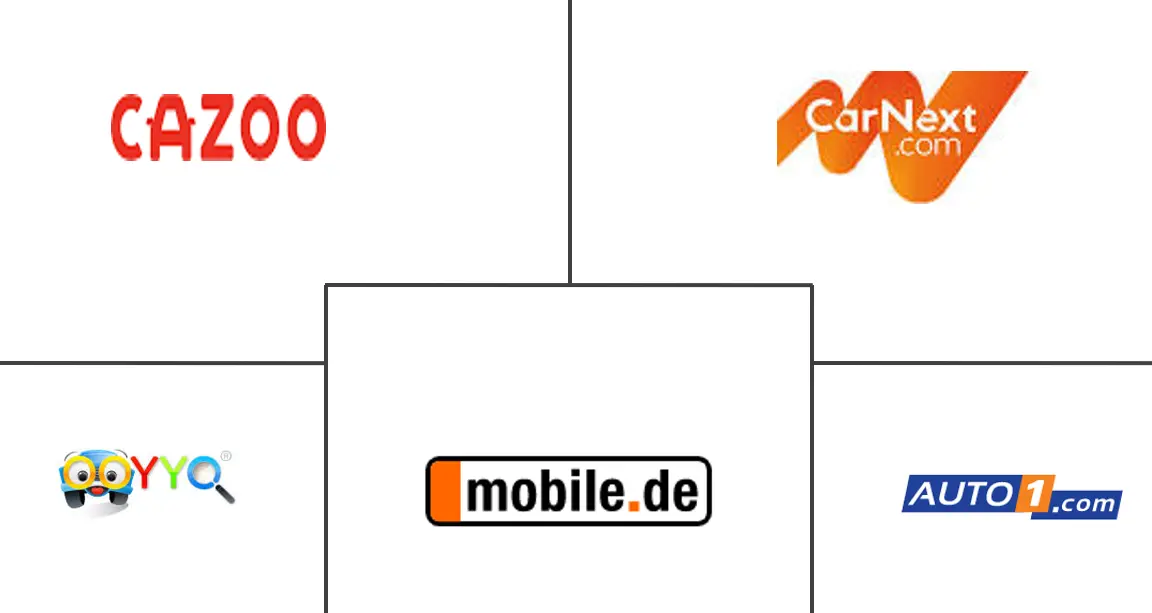Market Size of Germany Used Car Industry

| Study Period | 2019 - 2029 |
| Base Year For Estimation | 2023 |
| Forecast Data Period | 2024 - 2029 |
| Historical Data Period | 2019 - 2022 |
| CAGR | 7.12 % |
| Market Concentration | Medium |
Major Players
*Disclaimer: Major Players sorted in no particular order |
Germany Used Cars Market Analysis
Germany used car market was valued at USD 113.2 Billion in 2021, and it is expected to reach a value of USD 171.03 Billion by 2027, registering a CAGR of 7.12% during the forecast period (2022 - 2027).
Due to the global COVID-19 pandemic, countries were forced to temporarily reduce demand for both old and new vehicles. Furthermore, the global economic slowdown has affected consumers, resulting in a decrease in car sales; however, due to the risk of infection and the desire to maintain social distance, people all over the world have begun to avoid public transportation. According to the KBA, the used-car market in Germany contracted by 6.8 percent in the first six months of 2021. However, dealerships in the country could only reopen on a conditional basis in March 2021. This naturally had a greater impact on the new-car sector, with registrations down 24.8 percent in the first half. In December 2020, Schwacke predicted that slightly more than seven million used cars would be sold in 2021, roughly the same as in 2020. Furthermore, this volume of transactions would be less than 200,000 units short of the 7.2 million cars that changed hands prior to the pandemic.
Over the long term, market has grown significantly in recent years, with price competition among new players being one bright spot in the used car industry. The inability of customers to purchase new cars has become one of the reasons for the increasing volume of used car sales, which is complemented by investments made by industry participants to establish their dealership network in the market. These dealership networks aided market participants in brand development and the viability of used car options.
However, the used car dealer is relying on the seller since the dealer cannot obtain cars to serve their customers unless the owner sells it in the market. If new car sales fall, the market will run out of supplies after a while, this might hamper the market growth.
Germany Used Cars Industry Segmentation
A used vehicle that has earlier been owned is referred to as a used car. Used cars can be acquired from a variety of sources, both online and offline.
Germany Used Car market is segmented by vendor type, fuel type, body type, and sales channel.
By Vendor Type, the market is segmented into Organized and Unorganized. By Fuel Type, the market is segmented into Petrol, Diesel, Electric, and Others. By Body Type, the market is segmented into Hatchback, Sedan, and SUVs and MPVs. By Sales Channel, the market is segmented into Online and Offline. The report covers the market size and forecast in value (USD Billion) for all the above segments.
| Vendor Type | |
| Organized | |
| Unorganized |
| Fuel Type | |
| Petrol | |
| Diesel | |
| Electric | |
| Others |
| Body Type | |
| Hatchback | |
| Sedan | |
| SUVs and MPVs |
| Sales Channel | |
| Online | |
| Offline |
Germany Used Car Market Size Summary
The used car market in Germany is poised for significant growth, driven by a combination of economic factors and changing consumer preferences. The market has experienced fluctuations due to the global COVID-19 pandemic, which initially led to a decrease in car sales as demand for both new and used vehicles temporarily declined. However, the shift away from public transportation due to health concerns has bolstered the demand for used cars. The market is expected to expand as consumers increasingly turn to used vehicles, partly due to the rising costs of new cars influenced by stringent emission standards and the push towards electric vehicles. The decline in new car sales, particularly with the impending ban on diesel and petrol vehicles, is anticipated to further fuel the growth of the used car sector.
The landscape of the German used car market is characterized by a high degree of fragmentation, with numerous players ranging from independent dealers to franchised and multi-brand dealerships. The entry of new market participants and the adoption of e-commerce channels for promotion and sales are opening up new avenues for growth. Organized vendors are expected to capture a significant share of the market, benefiting from increased brand loyalty and the expansion of their dealership networks. The market is also witnessing a rise in the use of technology and digital platforms, which are enhancing the buying and selling experience. As major companies form partnerships and explore digital strategies, the used car market in Germany is set to experience robust growth in the coming years.
Germany Used Car Market Size - Table of Contents
-
1. MARKET DYNAMICS
-
1.1 Market Drivers
-
1.2 Market Restraints
-
1.3 Industry Attractiveness - Porter's Five Forces Analysis
-
1.3.1 Threat of New Entrants
-
1.3.2 Bargaining Power of Buyers/Consumers
-
1.3.3 Bargaining Power of Suppliers
-
1.3.4 Threat of Substitute Products
-
1.3.5 Intensity of Competitive Rivalry
-
-
-
2. MARKET SEGMENTATION
-
2.1 Vendor Type
-
2.1.1 Organized
-
2.1.2 Unorganized
-
-
2.2 Fuel Type
-
2.2.1 Petrol
-
2.2.2 Diesel
-
2.2.3 Electric
-
2.2.4 Others
-
-
2.3 Body Type
-
2.3.1 Hatchback
-
2.3.2 Sedan
-
2.3.3 SUVs and MPVs
-
-
2.4 Sales Channel
-
2.4.1 Online
-
2.4.2 Offline
-
-
Germany Used Car Market Size FAQs
What is the current Germany Used Car Market size?
The Germany Used Car Market is projected to register a CAGR of 7.12% during the forecast period (2024-2029)
Who are the key players in Germany Used Car Market?
CarNext.com, AUTO1.com GmbH, mobile.de, OOYYO Corporation and Cazoo Ltd. are the major companies operating in the Germany Used Car Market.

